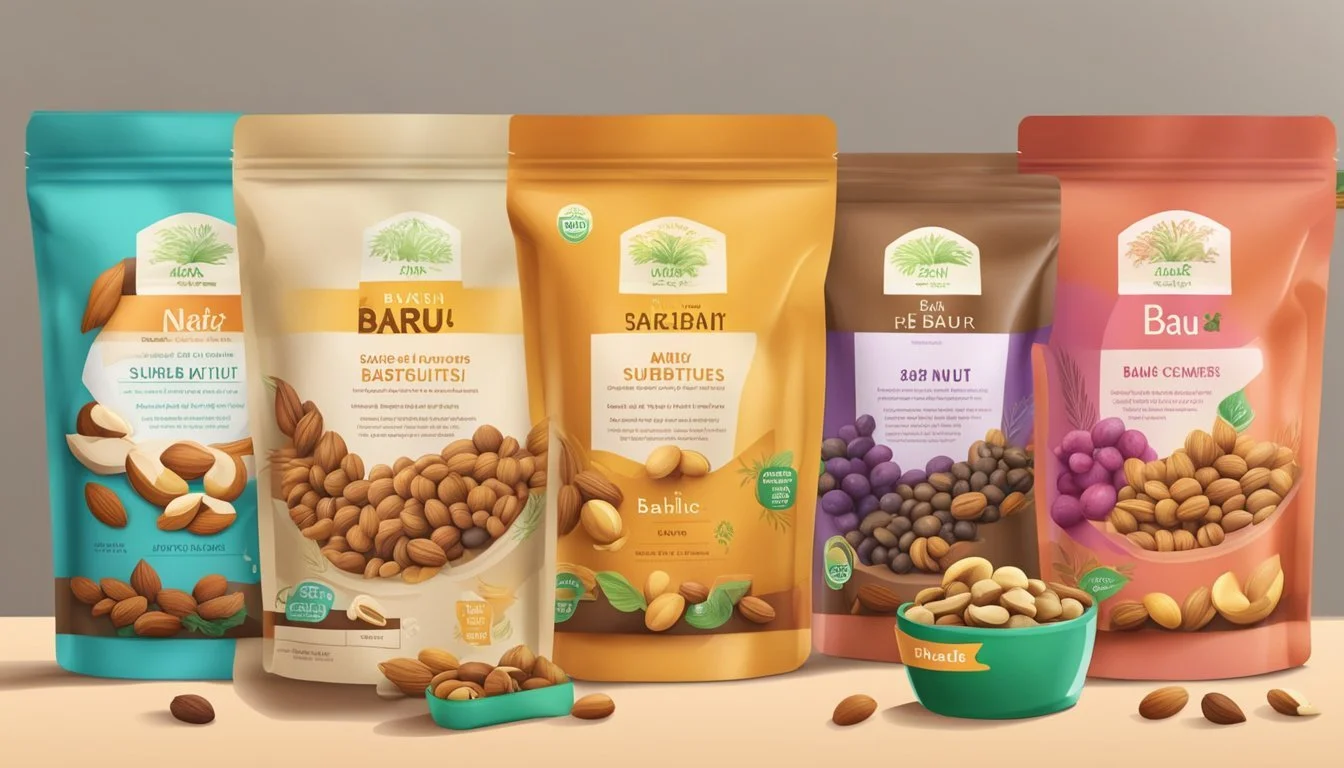Baru Nut Substitutes
Top Alternatives for Allergy-Friendly Cooking
Baru nuts, a lesser-known superfood, are gaining traction in health-conscious circles for their impressive nutritional profile. These nuts originate from the Cerrado savanna in central South America and are the seeds of the Dipteryx alata tree, a species that thrives in dry tropical lowlands. With a composition rich in protein, fiber, and a notable content of unsaturated fatty acids, particularly oleic and linoleic acids, they are often considered among the healthiest nut options available.
Despite their health benefits, baru nuts may not be readily available in all regions, prompting consumers to seek substitutes that can provide similar nutritional advantages. When looking for alternatives to baru nuts, it is essential to consider the nutrient content, particularly the balance of fats, proteins, and minerals. The precise composition of baru nuts, which includes a significant amount of oleic acid, minimal sodium, and no cholesterol, makes the task of finding an equivalent substitute challenging.
Individuals who incorporate baru nuts into their diets may do so to harness their potential health benefits, ranging from heart health support to weight management. The choice of substitute should closely mimic the nut's nutritional benefits to maintain the intended dietary outcomes. Factors such as texture and flavor may also influence the choice of substitute, especially when baru nuts are used in recipes or as a snack, further underscoring the importance of a well-rounded alternative.
Baru Nut Fundamentals
Baru nuts have recently gained attention for their unique nutritional profile and potential health benefits. This section explores their origins, nutrients, comparative advantages, and culinary applications.
Origin and Habitat
Baru nuts, native to the Brazilian savannas, thrive in tropical climates. They are the fruits of the Dipteryx alata tree, which is well-adapted to the Cerrado region, an area known for its rich biodiversity.
Nutritional Profile
A serving size of 30 grams of roasted, unsalted baru nuts typically contains:
Calories: 140
Protein: 7g
Fat: 10g
Saturated Fat: Approximately 2g
Carbohydrates: 12g
Fiber: Approximately 5g
Sugars: 0g
Sodium: 0mg
Furthermore, baru nuts are a source of essential minerals such as calcium, iron, potassium, zinc, and various micronutrients.
Comparative Benefits
Baru nuts stand out due to their lower fat content and higher fiber compared to many other nuts. They also have a notable antioxidant capacity due to the presence of bioactive compounds which contributes to their label as a superfood.
Culinary Uses
Baru nuts can be consumed raw or roasted and often find use in a variety of culinary contexts—from snacks to salads. Their unique flavor and nutritional benefits make them a versatile ingredient in both savory and sweet dishes.
Health Benefits
Baru nuts, known for their unique profile of nutrients, offer various health benefits that are vital for maintaining overall health. These benefits range from bolstering cardiovascular health to aiding in weight management.
Cardiovascular Health
Baru nuts are rich in mono- and polyunsaturated fats, which are beneficial for heart health. The presence of oleic acid, a monounsaturated fat, and linoleic acid, a polyunsaturated omega-6, can help maintain healthy cholesterol levels. Elevated HDL cholesterol (the 'good' cholesterol) and reduced LDL cholesterol are associated with a lower risk of heart disease.
Mono- and Polyunsaturated Fat Content: Known to support heart health.
Cholesterol Impact: Can help raise HDL cholesterol and lower LDL cholesterol.
Weight Management
The nuts' high fiber and protein content may assist with weight management by promoting satiety and reducing one's waist circumference. Additionally, the lower fat content in Baru nuts, compared to many other nuts, makes them a promising option for those monitoring their caloric intake.
Satiety: Both fiber and protein contribute to the feeling of fullness.
Fat Content: Moderate fat content helps manage total calorie consumption.
Antioxidant Properties
Baru nuts are not only a source of vital nutrients but also contain antioxidants and polyphenols, which may mitigate oxidative stress—a contributor to inflammation and various chronic diseases. By neutralizing harmful free radicals, these antioxidants strengthen the immune system and support overall health.
Antioxidants: Help combat oxidative stress.
Polyphenols: Contribute to reduced inflammation.
Nut Allergy Considerations
For individuals with nut allergies, incorporating baru nuts into a diet could be a potential alternative, considering the individual's specific allergies. Although one should consult with a healthcare provider, baru nut products, such as nut butter, might be a suitable substitute for other nut-based products.
Substitute: May be an alternative for those with allergies to more common nuts.
Consult Healthcare Provider: Necessary to ensure safety in cases of nut allergies.
Environmental Impact
The environmental impact of baru nuts as a food source is multi-faceted, with sustainability, deforestation concerns, and ecosystem preservation being at the core of this discussion.
Sustainability
Baru nuts, cultivated in the Brazilian savanna, also known as the Cerrado, offer an eco-friendly alternative to more water-intensive crops. They require no pesticides, and the trees have a positive effect on soil stabilization and prevention of erosion. Unlike other agricultural practices that contribute to a high water footprint, baru nut trees are well-adapted to the Cerrado ecosystem and utilize water efficiently.
Deforestation Concerns
While baru nuts can be a profitable crop, there is a risk of deforestation in the pursuit of expanded cultivation areas. Protecting forests in the Cerrado is essential, not just for the preservation of this unique ecosystem but also to prevent additional carbon release into the atmosphere. Responsible cultivation practices aim to minimize the impact by promoting the growth of baru trees in a way that does not encroach upon existing forested areas.
Ecosystem Preservation
The Cerrado, a vast tropical savanna, is crucial for biodiversity. The baru tree plays a pivotal role in this ecosystem by providing habitat and food for various species. By focusing on the cultivation of native species like the baru nut, conservation efforts can also turn profitable, aligning economic incentives with the preservation of the ecosystem. It stresses the importance of maintaining a balance between human activities and the health of the Brazilian savanna.
Culinary Applications
Baru nuts, esteemed for their robust flavor and nutritional value, offer versatility in various culinary applications, from snacking to intricate recipes. They are a high-calorie snack with a profile rich in Vitamin E, magnesium, and other phytonutrients that belong to the legume family.
Snacking and Trail Mixes
Baru nuts, often enjoyed roasted, add a unique taste and texture to trail mixes. Their calorie-dense nature makes them an excellent source of energy for snack foods such as granola or energy bars.
Roasted Baru Nuts:
Calories: High-energy snack
Taste: Rich and similar to peanuts
Trail Mixes: Often combined with seeds and other nuts
Cooking and Baking
In cooking and baking, baru nuts can substitute traditional nuts like pistachios or Brazil nuts, enriching dishes with their nutritional profile. They can be used whole, sliced, or ground into flour, contributing texture and taste to baked goods and savory dishes.
Nutrition: Vitamin E and magnesium-rich
Substitute: Versatile in recipes requiring nuts
Texture: Provides a crunch in cookies, bread, or pastries
Smoothies and Salads
In smoothies and salads, baru nuts serve as a nutrient-packed ingredient. Their high ORAC (Oxygen Radical Absorbance Capacity) value indicates a strong antioxidant presence, making them a smart addition for nutrition seekers.
Smoothies: Blend to add nutrients and a nutty flavor
Salads: Sprinkled on top for added texture and flavor
Phytonutrients: Enhances the nutritional value of vegetable-rich dishes
These nuts, harvested from South America, not only contribute distinctive flavor to various dishes but also pack an array of beneficial nutrients, making them a desirable ingredient for health-conscious food enthusiasts.
Market Insights
The Baru nut market demonstrates significant growth, driven by rising health awareness and consumer demand for nutritious alternatives. This section dissects the Baru nut market through consumer popularity, the nuances of production and distribution, and the influence of cost factors on availability.
Consumer Popularity
Baru nuts, native to the Brazilian savannah, are gaining traction due to their health benefits. Organic and non-GMO varieties particularly resonate with health-conscious consumers. Online retailers have helped boost their popularity by making them readily accessible on a global scale.
Production and Distribution
Production of Baru nuts is concentrated in Brazil, safeguarding the Brazilian savannah's ecosystem where these nuts thrive. They're often marketed as Baru almonds, although they aren't almonds. The supply chain from production to distribution is critical in protecting the quality and freshness of these nuts.
Cost Factors
The costs of Baru nuts are influenced by factors such as:
Profit: High nutritional value translates to greater demand and potential profit margins.
Drawbacks: Dependency on specific ecological conditions may result in limited production, thus affecting prices.
Protect: Efforts to protect and promote sustainable practices in production could impact cost.
By understanding these market dynamics, stakeholders can navigate the market's terrain more effectively.
Substitute Comparisons
In exploring substitutes for Baru nuts, this section examines how they compare to more traditional nuts and offers insights into various nut alternatives.
Baru Nuts vs. Traditional Nuts
Baru nuts have unique properties that distinguish them from traditional nuts like almonds, Brazil nuts, and walnuts. In taste and texture, Baru nuts are distinct with their own array of nutritional benefits.
Almonds: They have a higher omega-6 to omega-3 ratio compared to Baru nuts, which may affect inflammatory responses in the body.
Brazil nuts: While prominent for their selenium content, their omega-6 ratio significantly differs—Brazil nuts sit at a ratio of 232:1.
Walnuts: They offer a balanced omega-6 ratio close to that recommended by health guidelines and are known for beneficial antioxidant activity.
Cashews: With a creamy texture, cashews provide a similar mouthfeel to some Baru nut preparations and contain beneficial fatty acids, albeit less fiber.
It's important to note that dietary needs and culinary results may vary, and users should consider these when picking alternatives.
Nut Alternatives and Varieties
Various seeds and nuts can serve as stand-ins for Baru nuts depending on the application—whether for texture, flavor, or nutritional composition.
Pumpkin Seeds: These are an excellent crunchy substitute with a robust nutritional profile, often used in baked goods.
Sunflower Seeds: They're a versatile option with a crispness similar to Baru nuts, perfect for those avoiding tree nuts.
Pili Nuts: Highly comparable to Baru nuts in terms of their buttery flavor, pili nuts can be used in equal measure for replacing Baru nuts in recipes.
Pistachios: With a distinctive flavor, pistachios can add both texture and color to dishes that commonly include Baru nuts.
Selecting substitutes involves a balance between nutritional content and how the replacement will interact with other ingredients, particularly in family recipes or regional dishes from places like Bolivia, where Baru nuts might traditionally be used.
Conclusion
Baru nuts serve as a versatile substitute for traditional nuts in various dietary patterns. Rich in protein and low in saturated fats, these nuts are emerging as a nutritional powerhouse. They can easily be integrated into meals, providing a healthy boost without compromising taste.
Nutritional Profile:
Protein: High in plant-based protein
Fats: Predominantly contains mono and polyunsaturated fats
Vitamins and Minerals: Good source of phosphorus, iron, and potassium
Due to their unique nutritional composition, baru nuts can be considered a beneficial addition to one's diet. Whether eaten as a snack or used as a flour substitute in baking, these nuts have the potential to enhance the nutritional value of food.
It's worth highlighting the comparative edge baru nuts have in terms of sustainability. The plant's resilience to harsh climates alongside farming practices that promote ecological balance mark it as environmentally favorable.
For individuals with nut allergies, it is advised to exercise caution. While baru nuts may offer a healthy alternative, it is crucial to consult with a healthcare provider before incorporating new foods into an allergy-prone diet.
The incorporation of baru nuts into mainstream consumption still faces challenges in terms of availability and consumer awareness. Yet, their growing popularity indicates a promising shift towards diverse, nutritious food options. As baru nuts gain recognition, they are charting a path as a noteworthy addition to the nutritional landscape.







